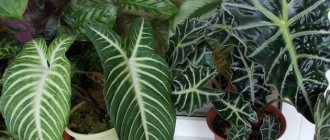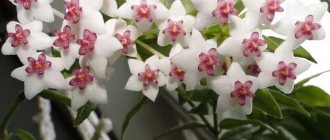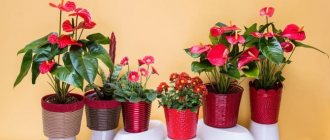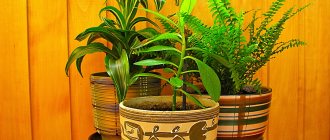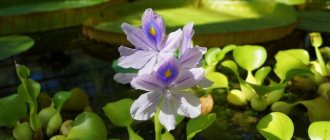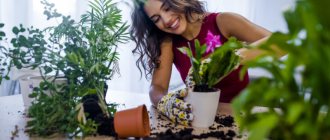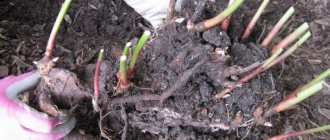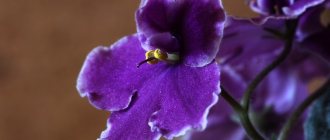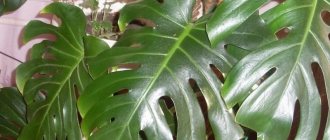Tradescantia
An ampelous plant, a resident of the tropics and temperate latitudes of America, is loved by gardeners for its lush crown of variegated white-green or pink-green leaves. The branches go up well, they are pinched to form a lush crown. Under the weight, the branches begin to droop and a lush bush turns out.
If you place Tradescantia on the floor without using a hanging pot, choose a tall pot for it. Hanging branches will reach the floor, which looks unaesthetic. And the roots are developed, so for the development of Tradescantia you need a lot of nutritious soil and moisture. Water it immediately after the soil dries from above, avoiding drought.
Palm trees
A wide variety of indoor plants, with different shapes and sizes of leaves. A characteristic feature is a long stem and a lush crown on top. The majority are native to the tropics of America, Africa, and rocky soils near water bodies.
Production of pots and cache-pots “StudioHome mini-trees EcodarMini-trees in your home for 147 rubles.
Three reasons why tall containers are suitable for palm trees:
- The roots of the palm are long and develop quickly to extract moisture from the soil layers.
- They like sandy soil, with good drainage, so that water does not stagnate at the roots, so fill the lower quarter of the pot with expanded clay.
- Palm trees grow slowly and do not like to be transplanted.
Some types of palm trees have roots that rise from the ground, this is another reason to choose a tall pot to cover them with moss or fine expanded clay.
Palm trees are suitable for a single location, look elegant and add an exotic flair.
What plants like big pots?
Experienced amateur flower growers and landscape designers are well aware that the comfortable existence of a houseplant depends not only on the correct composition of the soil and the creation of the desired microclimate, but also on such a prosaic thing as the dimensions of the pot. This parameter depends on the type and size of the root system.
Plants with small roots and bulbous
(sansevieria, ferns, Usamber violet, episcia, cyclamen, amaryllis, hippeastrum) grow well in shallow pots. Large, bulky pots with a lot of soil that is not penetrated by roots and therefore subject to oxidation are very harmful. For their comfortable existence, it is enough to periodically loosen the soil and provide proper watering.
Massive and large flower pots are suitable for large specimens with a developed root system. Only in this way can the necessary conditions for the growth and development of indoor plantings be provided.
However, excessively large pots can also harm the plant: lead to rotting of the root system or its too rapid development to the detriment of flowering.
Therefore, experts advise that before transplanting any plant, you should familiarize yourself with the basic rules for caring for a particular species.
For example, rose and ficus
“I like” not just large flower pots, but fairly narrow and deep ones.
The size of the flowerpot for such a beautiful and unpretentious plant as Schefflera
is determined by the need to create an impressive (at least 7 centimeters) drainage layer of small pebbles.
Also, large plants need impressive pot sizes: oleander, lemon, different types of palm trees
.
Today it is fashionable to grow bonsai
. These are trees with a well-developed root system, and they can be very tiny or huge in size. Of course, large bonsai require large flower pots. Ficus Benjamina, Bougainvillea, Murraya paniculata, and pine are most suitable for this style. Some gardeners grow cacti and aloe to substantial sizes.
Any large plant poses a huge challenge when replanting. This can be partially solved by purchasing plastic flower pots from LECHUZA. After all, they are much lighter and more convenient than their ceramic counterparts.
From us you can purchase pots and flowerpots in bulk of any shape and size. For more information, simply fill out the feedback form or call (495) 995-91-86
or write on the Contact page.
Your request has been sent, the manager will contact you shortly
Dracaena
Dracaena is native to South America, Central and Eastern Africa. It looks like a palm tree, although it is not one - a long stem and a lush crown of thin leaves, green or with a dark red border. Its appearance and unpretentiousness have made it a popular houseplant.
Dracaena requires only good lighting and moderate watering - closer to the window, but not in direct sunlight, and water as the soil dries. Dracaena's roots are superficial, but take a large container at once, as it grows quickly.
To highlight the beauty of Dracaena, choose a tall and narrow pot shape. By placing an adult flower in such a pot, you can visually increase the height of the room.
Bonsai
The culture of growing mini-trees originated in Japan. It sometimes takes ten years to grow a bonsai. For the living art of bonsai, different species are used - ficus, rhododendron, juniper and even trees - maple, elm.
The crown and branches are formed in such a way that the plant resembles a miniature tree - they are regularly pruned, intertwined, and pinched. At the same time, the roots continue to grow, and in order for the tree to receive nutrients and moisture, a lot of soil is needed. Bonsai are transplanted into small containers after they have achieved the desired shape.
Aglaonema
Aglaonema is native to the tropical rainforests of Southeast Asia. The plant is a bush of long, broad, variegated leaves that range in color from green to purple. A spectacular flower that people like to decorate rooms with, using species with different colors and color patterns.
Production of pots and cache-pots “StudioMini-trees in your home for 147 rubles.Home mini-trees Ecodar
As a resident of tropical forests, Aglaonema requires a lot of moisture and nutrition from the soil, so choose a tall pot for it. Its root system is developed, filling the entire volume of soil, so as not to disturb with frequent replanting, immediately plant it in a large container.
Due to the shape of the crown, Aglaonema looks better in tall and narrow containers. In wide ones it will look flattened. Therefore, the second reason for choosing this shape is decorative.
SELECTION OF A POT BY SHAPE
The shape of the pot is chosen according to the type of root system of your flower. If the plant has superficial roots, then it does not need a deep pot. For example, cacti and succulents are planted in low bowls. Usambara violets, peperomia, begonias and gloxinias do not need deep pots.
For ferns, aglaonema, stromanthus, arrowroot, azaleas, spathiphyllum, sansevieria, nolina, wide but shallow containers are needed, since their roots grow wider than deep. If you nevertheless purchased a deep pot for one of these plants, do not be discouraged: just add more drainage made of expanded clay or polystyrene foam to the bottom. This way you won't flood your flower.
But for plants with long taproots, deep pots are needed. These include palms, myrtle, ficus, hibiscus and other indoor trees. Don’t forget to add drainage to the bottom of the pot and be sure to make holes to drain excess water.
When choosing a pot, you need to remember the planting depth. Some plants, such as monstera, philodendron, syngonium, need to be buried, since they have aerial roots, and if you bury part of these roots into the ground, you will give the flower additional nutrition, and it will stay in the pot better. This means that a deep pot is also suitable for such plants.
When choosing the shape of the pot, do not forget that a tall plant planted in a low pot will be unstable and can easily tip over. This is especially true for cacti. It seems that everyone knows that cacti love low bowls, and they plant all types of cacti in them. But a small, prickly ball and a tall prickly pear are two different things, so keep that in mind when choosing a pot shape. Stones will help make the pot more stable if you use them to lay the soil.
When choosing a pot by height, do not forget that drainage will take 2-3 cm, and even more for cacti: up to 1/3 of the pot.
If you like a barrel-shaped or narrow-necked pot, think about how you will remove the plant from it the next time you replant? This will not be easy to do; most likely you will have to break the container.
So it’s better to buy a pot like a planter and put a smaller pot with a flower there, which can be easily pulled out when the time comes to replant. In this case, you need to purchase a pot that is quite voluminous, several sizes larger than the inner pot.
Anthurium
A luxurious plant from Central and South America, it looks impressive both in flowering and in decorative foliage form. The leaves are heart-shaped, with a matte or shiny surface. Flowers - white, red, but always in the form of a spadix, wrapped in a blanket.
Young Anthurium is planted in a shallow container, and for an adult, choose a tall cylindrical pot. This is necessary to stimulate flowering. When wide, the flower will produce shoots rather than buds.
Ficus
The most numerous type of house plants, including the popular ones - Elastica, lyre-shaped, Benjamin, dwarf.
They may be very different in appearance, but their care is the same, since their homeland is one climate zone - the tropics and subtropics of different continents. Good lighting, watering as they dry - there are no special requirements for caring for ficuses.
Since indoor flowers are grown for decorative purposes, choose a pot in which they will look advantageous. Most ficus plants are tall and need an appropriate container.
The ficus also requires drainage, so fill the lower quarter with expanded clay. Also, the size of the pot can slow down the growth rate of the flower if you take a larger one. Therefore, for adult ficuses, a cylindrical high pot is better suited, in which the plant will gradually grow upward.
Popular indoor flowers
Tradescantia is one of the most popular indoor flowers. It is famous for its beauty and ease of care. The leaves of the plant entwine the pot in a kind of carpet, hanging down. Their color varies: from light green with lilac streaks to purple. You can form a bush at will. Pinching young shoots makes the flower more magnificent. If it grows freely, it is easy to get long vines.
The plant is popular not only among gardeners, but also among aquarists. By planting it near an aquarium, you can grow a beautiful carpet on the surface. It is enough to lower the branches into the water.
Not everyone understands why Tradescantia will be comfortable in tall pots. This feature of the flower is associated with the roots. Then the voluminous green mass receives enough nutrition, the roots grow and fill the entire pot.
Many people like to grow palm trees. Caring for them differs depending on the variety. Voluminous green foliage spreads out in all directions. A palm tree can become not just a houseplant, but also a wonderful piece of furniture. It is better to plant the flower in a high pot so that the roots can grow freely - they will give more juice to the green mass, which will contribute to its increased growth.
Houseplants. The illustration for the article is used from open sources.
Dracaena does not require complex care. To successfully grow it, you only need to follow the basic rules. The light must be diffused, because direct exposure to sunlight is considered harmful. Regular watering and irrigation with a spray bottle will allow you to get a healthy bush with spreading foliage. Proper planting of dracaena is of great importance. The maximum height of the plant reaches 3 m. To grow a flower, you need to use a high pot - the root system and the above-ground part of the plant will be healthy.
Now it has become fashionable to grow bonsai. Trees come in both tiny and gigantic varieties. For the latter, it is advisable to purchase tall and large pots. For example, Ficus Benjamin grows better in such containers. Pine and Murraya paniculata love tall pots.
For some plants, huge pots will be disastrous. The rule applies to bulbous flowers and specimens with small roots. These include cyclamen, amaryllis, Usambara violet, fern and hippeastrum.
Schefflera
Schefflera can be found in the tropics of any part of the planet. In nature, it grows to the size of a tree; decorative species are more compact, reaching 2 meters in height.
Flower growers love it for the shape of its leaves - when gathered together they look like an open palm or an umbrella. They can be dark green or with yellow and white stripes. Sheflera is grown like ficuses - as a small upright tree or I shape the crown so that it becomes a lush bush.
In any case, this is a large plant and it needs a tall pot. Experienced flower growers advise replanting Schefflera each time in a much larger pot. A lush crown requires a lot of nutrition and moisture, so there must be a lot of soil.
SELECTING A POT BY SIZE
So, the most important thing that affects the well-being of your flower is the size of the new pot. This sometimes determines whether a plant will live or die. See for yourself: if you buy a pot that is too small, the plant will soon have to be replanted into a larger one. For you, this means extra costs and hassle.
In principle, the plant will not suffer much if you transplant it into a large container quickly. But if you delay, the soil in the pot will instantly dry out and quickly become depleted. You will have to constantly ensure that the flower does not dry out and feed frequently. It must be said that not everyone succeeds in this, and the flower in inexperienced hands often dies from drying out.
Consider the second option: you purchased a pot that is too large, and this is also bad. Not all plants can quickly master the provided volume; growth may slow down, and if watered incorrectly, the flower may even die, since the constantly moist soil will sour and the roots will simply rot.
Therefore, before you go to the store for a new pot, make sure: does your flower really need to be replanted in a larger volume?
How to determine that a plant needs replanting? Carefully inspect your plant and pay attention to the following factors:
- Check to see if roots are sticking out of the drainage hole? If “yes,” then you need to urgently replant.
- What does your plant look like? How proportional does the top look compared to the root system? If it is too big and the root ball in the pot is small, then it’s time to replant.
- How quickly does the soil dry out after watering? If it is very fast, or the water simply flows down the walls of the pot into the tray, it means there are a lot of roots there, and the plant needs a new pot.
If you cannot visually determine the need for replanting, remove the plant from the pot. Inspect the roots: if the ball of roots has completely entwined the ground, then the plant needs a pot 1-2 sizes larger. This means that its diameter should exceed the diameter of the old pot by 2-4 cm, depending on the type of plant.
If the roots have loosely entwined the ball, but you just want to replace the pot with a nicer one, then choose the same size as the old one, or a little larger. But this method is only suitable for healthy young plants.
Which pot should you choose if you want to quickly get a large plant?
Large plants are expensive, and not everyone can afford them. If you want to quickly get a large specimen, buy a large pot, 2-4 times larger than the old one. This can be done, but only if you have a fast-growing plant and it has a well-developed root system.
Such plants include vines and young indoor trees, and only then, provided that you have some experience in growing plants. If you have no experience, you can flood the flower, the roots will suffocate and rot, and your green pet will die. So be careful with watering!
If you nevertheless overwatered the plant and its roots rotted, or you have a sick and weakened specimen, then it is transplanted into light, permeable soil in a pot of the same size, or even a smaller one.
Look how many living roots are left there. The fewer there are, the less utensils are needed for transplanting. And do not forget to remove all rotten and damaged roots and completely replace the soil. Do not overwater the plant after replanting, water very little at a time.
